Day 4: Shinkansen Bullet train ride - Hello Nara - Nara: An Introduction - HORYUJI TEMPLE - Jikoin zen temple
Horyu-ji Temple, Nara
Our Nara trip commenced by a visit to the Horyu-ji temple, acclaimed to be the very first national heritage of Japan. And the moment we stepped in, we could see exactly why!
Situated in Ikaruga, Nara Prefecture of Japan and spread in an area of 187,000 sq mtr of land, Horyu-ji temple (Temple of the Flourishing Law of Buddhism) is huge and dedicated to a statue of Buddha literally meaning ‘Arrival as a healer’. Besides being a place of prayer, the temple today is globally renowned for housing the world’s oldest surviving wooden structures which shed ample of light on a few significant pages from a rich book of Japanese history.
Chu-mon middle gate, built in 607
As we passed through the middle temple gate, all my eyes could see were old wooded historical buildings and structures strewn all around, all of them promising enough to take me back to an era gone by. As someone who loves delving into myths, legends and stories, it was easy for me to fall in love with this place and the wonderful guiding company in Sarah, cosmos and a local guide only made it so much more easier.
Old wooden columns in the temple
The entire temple precinct is divided into two parts - the Sai-in in the west and the To-in in the east, each containing notable places like the Kondo hall, the temple's five-story pagoda, the octagonal remarkable Yumedono Hall, etc. Together, we did a lot of hopping, around the premises trying to make the best of the temple precincts in the time available to us.
Kondo (Main Hall), Western part
This is the main hall in the temple that gives you a glimpse into the temple's history. The Horyu-ji temple and a Buddhist statue was originally a wish of Emperor Yomei as a prayer for his recovery from an illness. Sadly enough, that desire was never to be fulfilled and he died soon after. However, his son - Emperor Shotuku kept his father's wish alive by building a temple and a statue of Buddha, the same one that we see enshrined in the Kondo hall today.
The Kondo hall
The Kondo hall was dark and when a few rays slid in to light up the various enshrined images, the best-known is the Shaka triad,
the splendor was magnificent!
the splendor was magnificent!
Goju-no-to (Five Storey Pagoda), Western part
Just besides the Kondo hall is the five storey pagoda celebrated as the oldest surviving structure in the world.
The Kondo hall (left) and the five storey pagoda (right)
As I stood underneath this massive structure, Goju-no-tu, 32.45 mtrs tall,
I felt torn so as to what of it to admire –
The intricate beauty of tall structure or the fact that it such an antique.
The structure was equally impressive and daunting, both at the same time!
Yumedono Hall or The Hall of Visions, Eastern part
Yumedano Hall
Located at the heart of the temple complex, the hall of visions houses beautiful life size statue of Prince Shotuku dating back to the eight century, believed to be a manifestation of Kuse Kannon. People pray for the peace of his soul here.
Other Places to see inside the temple -
1. Shoryo-in, Hall of Prince Shotoku’s soul

Hall of Prince Shotoku's soul
Built in the in the 13th century, this place houses the statues of Prince Shotoku along with a few more people associated with him. We did not go inside but just ringing the bell hanging outside gave a unique sense of peace.
2. Daiko-do great lecture hall, Western Part
Daiko-do hall
Daiko-do hall was originally built in 925 as a place for monks to practice their Buddhist studies and a place where memorial services could be conducted. Unfortunately, it was burnt down when lightening struck and had to be reconstructed in 990.
3. Gallery of Temple Treasures
Just moments after walking in here, I realized the place indeed stays true to its name. The gallery is a vast treasure house of valuable and ancient Japanese culture, arts and crafts very carefully preserved within its walls. Spanning an impressive journey through the long history of Horyuji, the items on display include miniature pagodas, various murals and other historical treasures. Photography is not allowed inside.
-- Kudara Kannon do (The Kudara Kannon Hall), Eastern part
Located inside the gallery, was an image that was so mystical and impactful that it has stuck in my mind till date.
The Kudara Kannon Hall (in the gallery of temple treasures) houses a slender and elegantly graceful Buddhist statue of the Kudara Kannon. He holds a healing potion in his right hand and a blessing in his left, which says - Come to me, I will heal you. As I stared into his deeply compassionate eyes, I could feel a strange aura envelop my body. And I could feel a surcharge of positivism flow in my heart... as if, it were pouring straight out of the healing pot right into my soul.
We spent a few quiet minutes in the hall simply staring at the powerful image. This undoubtedly, for me, formed the highlight of the Horyu-ji temple. However, sadly, photography was prohibited inside the hall.
The Kudara Kannon Hall (in the gallery of temple treasures) houses a slender and elegantly graceful Buddhist statue of the Kudara Kannon. He holds a healing potion in his right hand and a blessing in his left, which says - Come to me, I will heal you. As I stared into his deeply compassionate eyes, I could feel a strange aura envelop my body. And I could feel a surcharge of positivism flow in my heart... as if, it were pouring straight out of the healing pot right into my soul.
We spent a few quiet minutes in the hall simply staring at the powerful image. This undoubtedly, for me, formed the highlight of the Horyu-ji temple. However, sadly, photography was prohibited inside the hall.
Besides all of the above, Horyu-ji temple had a lot in it's complex grounds still to be seen and savored.
A stone slab in the temple premises
But, after a lot of walking and good exploring around for around 3 hrs, we decided to move on to our next place in the itinerary.
Tips for Travellers:
1. The place is vast, both geographically and historically, so take care not to cram too much into your itinerary lest you exhaust time for the other spots in the city.
2. You need a lot of time and energy if you wish to go for the entire temple tour but the place is so deeply soaked in history that a small tour is also enough to get a gist of the place.
How to reach:
Horyu-ji is located about 12 km outside of central Nara. One can catch a train from
JR Nara Station and take the frequently departing Yamatoji Line to Horyuji
Station. From there, it is a 20 minute walk or 5 minute
bus ride to the temple.
Temple Timings: 8:00 to 17:00 (until 16:30 from early November to late February)
Fees: 1000 Yen.
Previous Posts from the Japan Trip -
1. Planning for Japan: Visa, Flight Bookings, Hotel Reservations, etc.
1. Planning for Japan: Visa, Flight Bookings, Hotel Reservations, etc.
3. Entire Day 1 of Japan (includes Review of Hotel Villa Fontaine Roppongi, Tokyo, Expedia Japan Office Meet: An Afternoon to Remember)
4. Entire Day 2 of Japan (includes SensoJi temple: Asakusa - Tokyo, Nakamise Dori Shopping Arcade in Tokyo, Sumida River Cruise, Tokyo, A Stroll in the Hibiya Gardens, Imperial Palace and East Gardens, The Tokyo Tower, Japan)
5. Entire Day 3 of Japan (includes Meiji Jingu Shrine, Tokyo, ISKCON Temple, Funabori in Tokyo, Epson Aquarium, Shinagawa in Tokyo

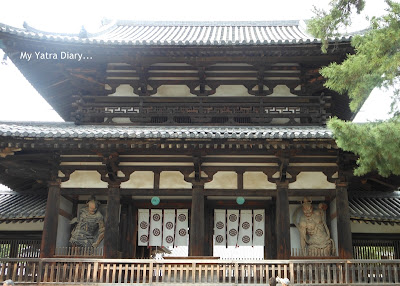
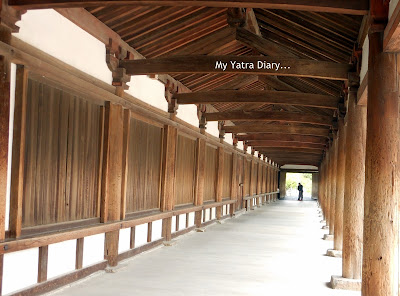
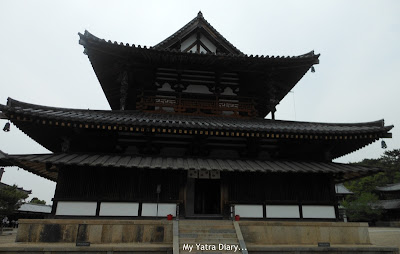
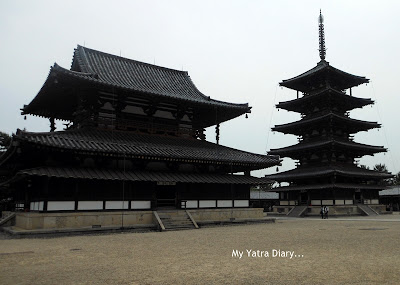


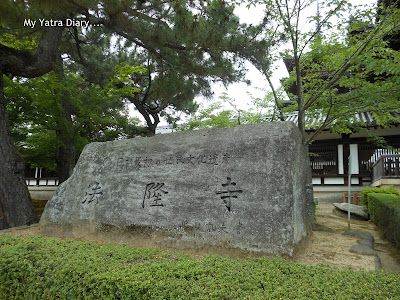
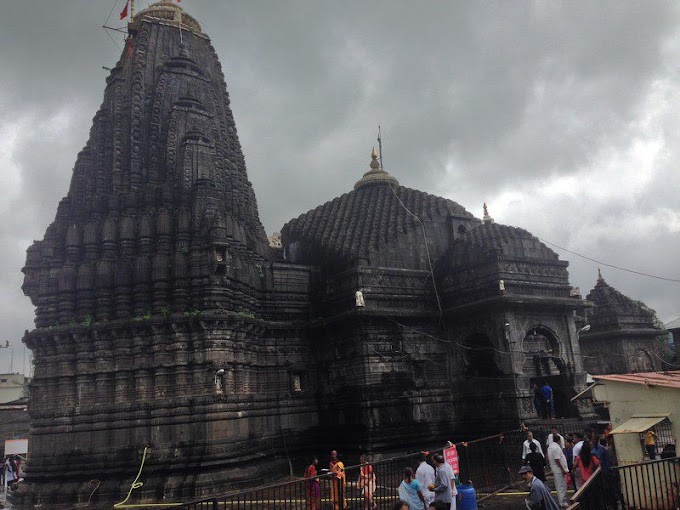

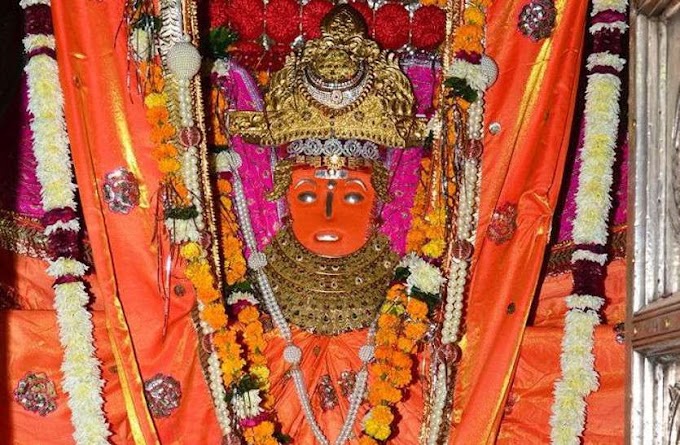

46 Comments
Those structures look brilliant. You have captured them well. Nice post Arti.
ReplyDeletehttp://rajniranjandas.blogspot.in/2012/12/the-sussegad-beaches-of-bardez-goa.html
I do so love the trips you take us on, Arti, via your wonderful captures and the information you include!! The next best thing to being there myself!! Hope you've had a great week and have an even better weekend!!
ReplyDeleteJapanese temples always look so effortlessly powerful.
ReplyDeleteAnother Gem of Post in your Japan Journey.
ReplyDeleteWhat amazes me how you keep a check on difficult Japanese words.
Also this part of Japan you get a sense that it is vast and has lot of space and then there is Tokyo which is very low on space.
Does more people live in Tokyo then interior of Japan ?
What a beautiful temple!
ReplyDeleteWow, this looks like the place I might choose of all the ones you have shown. The old wood is very well kept and beautiful!!! It almost glows.
ReplyDeleteBeautiful architecture, nice gardens. I'd like to visit Japan once. The only fear I have is about food... :)
ReplyDeleteBeautiful temple...just awe-inspiring. You saw so much on your trip..this is wonderful. I used to see a blogger from Nara, but have lost track of her posts. It seems like a beautiful city full of history.
ReplyDeleteas always you left me in awe at the beauty of the place you visited...as I read and viewed the photos I felt that inner peace that you felt...even though you have no photos of some of the most magnificent things inside those halls your description is enough to make me marvel...I would love to stare into the deeply compassionate eyes of the graceful Buddhist statue of the Kudara Kannon and experience that healing sensation you had...thank you for taking us to a wonderful virtual tour of Japan once again :) blessed weekend to you....
ReplyDeleteIt is amazing how the Japanese have preserved their cultural heritage despite natural calamities striking often! Arti, you have done full justice to your trip to the Land of Rising Sun, by sharing the journey with us:)
ReplyDeleteGood morning Arti. Read your yatra post. Great description with beautiful photographs. Thank you so much :)
ReplyDeletewhat very valuable tips you have shared for future travelers to Horyu-Ji Temple in Nara, Arti. I feel like I have a taste of its history already reading from you and seeing your images.
ReplyDeleteBeautiful (and ancient) temple Arti. It seems you have captured the temple from all the angles :)
ReplyDeletegood to read spiritual travel blog...
ReplyDeleteI just fell in love with Horyu-ji temple. How magnificant that wood work architecture is. I can understand how bad it feels when photography is prohibited at such beautiful places.Thanks for this post Arti. Have a lovely weekend.
ReplyDeletelooks like your japan odyssey is till going on..lovely!!
ReplyDeleteVery well written and photographed post...
ReplyDelete@Abhishek Bhardwaj: I myself am not sure on the words, Abhishek. I make it a point to check on them on the internet or the pamphlets that I have brought back from Japan to make sure I am using the right ones. And then, my Japanese friends are always around to correct me when I am wrong.
ReplyDeleteI think your observation on space stems from the fact that Nara has no skyscrapers and goes easy on malls and other such things. On the other hand, Tokyo, also the capital of Japan, has it all and it is also the most populated of all cities in Japan.
@Dave: You need to worry about the
food only if you are 'pure vegetarian' and that too can be averted if you take some time out to google things out beforehand. This is especially true for bigger cities like Tokyo. Smaller towns like Nara can be a bit fearful though.
@Sallie: Nara and Kyoto are stuffed with learnings, nature and history. I am sure, you will love it. Please Check if the Nara blogger is from one of these I have mentioned in this post - Hello Nara
ReplyDelete@Kulasa: Thank you kulasa for such a wonderful comment. The Japanese Temples have that calming effect inbuilt, one reason that I can see why... is that most of them are seated comfortably in the serenity of nature.
@Rahul Bhatia: It is amazing indeed! They do restoration work on these sites often. We can surely learn a thing or two from them about preserving our national heritage.
Such a contrast to your normal posts, as always I've enjoyed sharing in your Japanese adventure. Thanks for sharing not only your photographs but your thoughts.
ReplyDeleteThank you nice explanation. You know better about this temple than I,who guided you.
ReplyDeleteMy favorite is the same as yours. It's The Kudara Kannon. You explain the statue very well. I am looking forward to your guid of the next place.
Have a nice weekend!
Well written. Sky Tree was used the way of building of five storey pagoda. Old knowledge is amazing.
ReplyDeleteLovely temple , nice and elaborate description . Thanks for the virtual tour .
ReplyDeleteThank you Arti for all the picture, it's look great, from the building i can see if this place have strong spirituality power, throught the age :)
ReplyDeleteI just click google and search about Kudara Kanon the Avalokiteśvara, it's interesting because many indian influence on it :)
Love the walkway!
ReplyDeleteLovely pictures - such beautiful buildings!
ReplyDeleteFantastic info, and I hope to visit Japan one day!
ReplyDeleteWhat a beautiful place! I really like how many different kids of structures they have in this area. I love Japanese architecture so I could have spent hours here.
ReplyDeleteSuperb..!
ReplyDeleteYes Arti, I saw your comment on the latest post by Keiko on her blog about Nara.
ReplyDeleteJapanese structures are always beautiful, they have a classic charm. Beautiful pictures, Arti. :) Waiting to read about your Melbourne journey soon. You are supposed to travel to Melbourne this month I believe?
ReplyDeletestructure of temple is entirely different, photos are good
ReplyDeletethanks for sharing
Hi. Your photos are very beautiful. I remembered the days when I went there.
ReplyDelete@Sarah: That is very humble of you to say that, Sarah. Of course, my explanations stand nowhere to your ways of guiding me around. It was a real pleasure visiting the temple with both of you. Thanks once again :)
ReplyDelete@cocomino: That is something I did not know! Goes to show how the
engineering of yesteryear's was so much more advanced than today's! Thank you for sharing :)
@Akshay Kumar G: No idea and in no hurry too :)
So graphic tese roof shapes. Japanese have such a feeling for strong yet simple and elegant shapes. Have a lovely monday dear Arti!
ReplyDeletebeautifull post on the japanese temples...the 5 storey pagoda looks so unique...it amazes me whenever I see such structures that in our ancient times the architects must have had a aesthetic sense.Your earlier post on the town of Nara was very nice too, clean and beautiful town.I think the state of our mind can be reflected by our surroundings.Wish our cities could be as beautifull...luckily our indian villages still have a rustic beauty and charm.
ReplyDeletebeautiful pics, look at the way the temple has been kept so much clenanliness and compare to the temples here we have in our nation ..
ReplyDeletethanks for sharing
Bikram's
The temples are so different from anything else around the world. I love the style of them.
ReplyDeleteThese traditional wooden structures are a work of art. That pagoda does stand out.
ReplyDeleteWonderful shots of the temple.
ReplyDeleteI have been spellbound by the whole Japan series...great work indeed Arti!
ReplyDeletePadmapriya T S
http://aalayamkanden.blogspot.com
A wooden structure surviving for so long is a marvel in itself-not to speak of the beauty n cleanliness.
ReplyDeleteYou gave me a nice trip Arti!!!!!
As usual you provide us with a virtual trip Arti!
ReplyDeleteArti, your blog has a very soothing effect. The peace and pregnant silence that you felt in these pagodas, prayer halls, monastries etc. of Japan spill over through your serene pics and wonderful write up. Once upon a time I had passion for travelling. Nowadays due to various reasons I am unable to travel much. But your blog is my window to the world
ReplyDeleteSo much of Japan remains unseen. Thanks for showing us what I may never see otherwise.
ReplyDeleteArti, are most of the temples in Japan are Buddhist?
ReplyDeletedo they have any other religion other than Buddhism? (want to know out of curiosity)
Delighted you stopped by... Your suggestions, feedback are really appreciated. Thanks a lot :) Hope you visit again!
If you have asked a question, please give me at least 2 days to reply back. Thank you :)